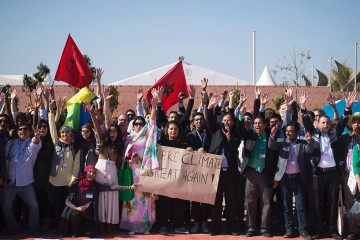

A long stretch of land in North Africa revered for its snowy mountains, pillowy dunes, crashing waves, and lush forests, Morocco is undoubtedly one of the earth's most picturesque climates. With such scenery, it's natural that the North African country was quickly earmarked as a poster child for the eco-movement in the MENA region.
Yet, should you have driven down the highway leaving Casablanca ten years ago, it would’ve been difficult to ignore the crops of multi-coloured plastic bags that lined the roads and were stuck to nearly every bush and branch. If you didn’t know any better, you might even think Moroccan farmers were growing the country’s plastic supply. In 2016, Morocco was the second-largest consumer of plastic bags in the world, coming in just after the United States. Its population of 34 million used an overwhelming three billion plastic bags annually. Something needed to change.
"While Morocco missed its original 2020 target of relying on renewable energies for 42% of its power, it pledged to use 52% renewable energy for its electricity needs by 2030. The country also plans to reduce its total emissions by 17-18% by 2030"
Five years ago, the country instituted a plastic bag ban, which outlawed the production or use in the country. Today, locals can package their produce in brown paper sacks or reusable polyester bags. They aren’t entirely waste-free alternatives, but the streets, cities, and rural fields are mostly free from the monstrous amount of plastic waste that once plagued them.
But it’s not just waste management that’s propelling Morocco into a greener future. A few years ago, the idea of not eating meat was preposterous. And if someone chose to omit dairy and eggs from their diet, they had better have a death wish. Slowly, more restaurants and shops are offering vegetarian and vegan options.
Carrefour Gourmet in Rabat boasts an impressive selection of Violife vegan cheeses and Alpro dairy-free puddings. They even have almond milk Ben & Jerry’s and dairy-free mochi ice cream for those sweltering summer afternoons. To an outsider, this may look like a modest but unsurprising selection of vegan treats. But any vegan Moroccan knows how precious (albeit expensive) these choices are.
|
That’s not to say the average person in Morocco is lowering their meat consumption. In the early 2000s, the already rising poultry meat consumption skyrocketed and peaked at 20.8 kilograms per person annually in 2011. Traditionally, however, Moroccan food contains very little meat. Tagines feature a modest portion of chicken, beef, or fish surrounded by vegetables and eaten with rounds of fresh bread. Fruit smoothies, roasted chickpeas, and charred corn are sold in corner shops and by street vendors. And if you’re looking for something light, there are several traditional vegetable and bean soups to warm your stomach and soul.
Unfortunately, the stigma that meat equals wealth is still prevalent. When a kilogram of beef is significantly more expensive than a kilogram of fruits and vegetables, it’s difficult to convince people to serve guests an entirely vegetarian meal without making them feel like their visitors weren’t ‘worth’ the few extra Dirhams. Meanwhile, fancier restaurants in Morocco seldom offer vegetarian entrée options.
Are Moroccans more familiar and accepting of the idea of not eating meat? Yes. Is Moroccan society and culture at the point where people are ready to start making changes in their own life? Not quite – but it is moving in the right direction, and the increasing amount of choices available suggests there’s a large enough demand to consistently import and offer these products and options.
When it comes to energy production, Morocco has made an impressive amount of globally recognised advancements. The world's largest solar farm is located in the Drâa-Tafilalet region, just 10 kilometres away from the town of Ouarzazate. It spans over 3000 hectares and from above, looks like thousands of shimmery shark scales glistening in the middle of the desert.
"The [Moroccan] people and government are slowly moving towards a greener future, from what they stock on their shelves to how they power their light bulbs. Nothing is going to happen immediately, but in some ways, it probably wouldn’t be very Moroccan if a little patience wasn’t involved"
While Morocco missed its original 2020 target of relying on renewable energies for 42 percent of its power, it pledged to use 52 percent renewable energy for its electricity needs by 2030.
The country also plans to reduce its total emissions by 17-18 percent by 2030. All in all, Morocco is doing a great job working towards combating climate change by introducing new policies and pledges.
The facts speak for themselves when it comes to building a greener country. While Morocco still needs to work on minimising financial support for oil products, it has increased renewable energies and lowered government support for fossil fuels, which has ultimately helped decrease the country’s carbon footprint. As of 2021, Morocco’s per capita emissions are less than half the global average.
The small North African country is easy to overlook when it comes to combating waste and energy issues. Morocco is renowned for its culture and landscapes, not its policies and solar farms. But the people and government are slowly moving towards a greener future, from what they stock on their shelves to how they power their light bulbs.
Nothing is going to happen immediately, but in some ways, it probably wouldn’t be very Moroccan if a little patience wasn’t involved.
Yasmina Achlim is a Moroccan-American freelance writer who loves good vegan food, living consciously and dressing sustainably.




 Follow the Middle East's top stories in English at The New Arab on Google News
Follow the Middle East's top stories in English at The New Arab on Google News


